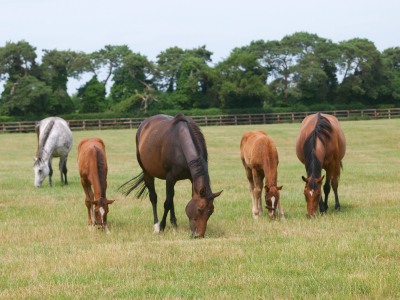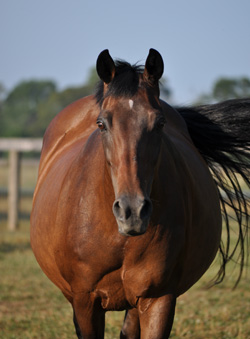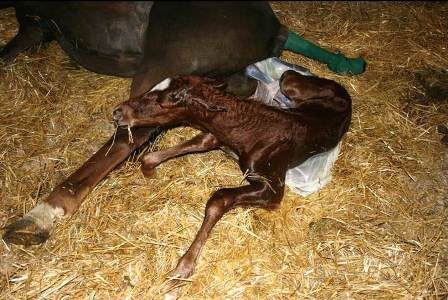 Colic is usually a word that brings to mind fussy sick newborn children, sleepless nights, and sleep-deprived parents, unless you are a horse owner. Many horse owners live in fear of finding their horses in an episode of colic. Fortunately, many bouts of gastro-intestinal pain are mild, easily treated, or easily managed on the farm or with a visit from your veterinary professional. More serious episodes could be much more in depth, require extended medical therapy and possibly abdominal surgery. No episode of colic should be taken lightly and often times, intervention by your veterinary team can help prevent escalation of the pain and disease in the horse. In cases of serious colic, swift intervention can positively affect the outcome of prolonged hospitalization or surgical repair.
Colic is usually a word that brings to mind fussy sick newborn children, sleepless nights, and sleep-deprived parents, unless you are a horse owner. Many horse owners live in fear of finding their horses in an episode of colic. Fortunately, many bouts of gastro-intestinal pain are mild, easily treated, or easily managed on the farm or with a visit from your veterinary professional. More serious episodes could be much more in depth, require extended medical therapy and possibly abdominal surgery. No episode of colic should be taken lightly and often times, intervention by your veterinary team can help prevent escalation of the pain and disease in the horse. In cases of serious colic, swift intervention can positively affect the outcome of prolonged hospitalization or surgical repair.
The causes or etiologies of colic is very long but clues in a horse's age, diet, reproductive status, diagnostic testing, abdominal palpation, and response to pain medication can go a long way in determining the cause of the discomfort and the most appropriate therapy for resolution of the episode.
For pregnant or recently post-partum mares, colic is particularly troublesome because the well being of both the mare and fetus (or foal) are in jeopardy. Furthermore, mares can have certain levels of normal discomfort as a late term fetus is moving around in the uterus or in response to oxytocin release in recently post-foaling mares. I break down broodmare colic into three categories:
- Pre-partum (last trimester of gestation)
- Peri-partum (within two weeks of expected foaling date)
- Post-partum (within one week of foaling)
The caveat to my broodmare colic list is that some etiologies of colic can occur in any population of horse. Some examples include aged horses that develop a strangulating lipoma, ileal impactions when ingesting coastal Bermuda grass, gas colic from over fermentation of feed, or sand colic. These are just a few of the etiologies of colic observed around the country but when investigating colic in a mare that fits the timing of the categories above I try to rule out the following causes.
Pre-partum Mares
 Pre-partum mares, or mares after 8 months of pregnancy that present for colic should automatically be evaluated for a uterine torsion. It is infrequent in nature but will occur in mares most commonly after 8 months of gestation. Intermittent signs of colic that respond to pain medication (analgesics) that return when the medication has subsided is very indicative of a possible Uterine Torsion. A torsion in the mare occurs in front of the cervix, so a vaginal exam will not be diagnostic. Instead, rectal palpation of the broad ligaments can diagnose and determine the direction and degree of torsion. Oddly, the mare’s pregnant uterus will rotate with an equal frequency clockwise or counter-clockwise.
Pre-partum mares, or mares after 8 months of pregnancy that present for colic should automatically be evaluated for a uterine torsion. It is infrequent in nature but will occur in mares most commonly after 8 months of gestation. Intermittent signs of colic that respond to pain medication (analgesics) that return when the medication has subsided is very indicative of a possible Uterine Torsion. A torsion in the mare occurs in front of the cervix, so a vaginal exam will not be diagnostic. Instead, rectal palpation of the broad ligaments can diagnose and determine the direction and degree of torsion. Oddly, the mare’s pregnant uterus will rotate with an equal frequency clockwise or counter-clockwise.
Treatment depends on the degree of rotation, the timing of diagnosis, and the facilities available to the practitioner. One non-surgical technique involves correcting the torsion by hand through the cervix. Obviously, for this to work, the mare has to be at term with a viable fetus and a dilated cervix. The other non-surgical technique is “Rolling the Mare” to correct the torsion. The mare must be put under general anesthesia and correctly rolled while using a board on the outside of the abdomen to help stabilize the foal in one location. This procedure should not be performed on the near term mare.
Surgery is indicated if the torsion is unable to be corrected by rolling or if there is fetal distress or evidence of tissue damage to the uterine structures. Surgery can be performed either in a standing mare through the flank or with the mare completely under anesthesia by a ventral midline approach. Facilities, surgeon preference, economic considerations, and concurrent health issues of the mare or fetus all play a role in determining what approach to attempt.
Peri-partum Mares
Peri-partum mares have two etiologies of colic that are both emergencies and life threatening. Large colon torsion and rupture of the base of the cecum are two potentially catastrophic colic episodes that occur in the time before foaling. Large Colon Torsion more commonly occurs after foaling when the volume of the mares uterus, the fetus and fetal fluids have been evacuated and the there is a higher likelihood of the mares colon moving, rotating, and becoming a surgical emergency. It can occur prior to foaling, but since it is more common as a post foaling event, I’ll discuss it in the next section.
Rupture of the cecum usually has a poor outcome for the mare. Late term mares can have a perforation at the base of the cecum that allows gastrointestinal contents, bacteria, and debris to spill into the abdomen of the mare. Causes are unknown and range from increased abdominal pressure to movement of the fetus causing the rupture in the cecum. In any case, the mare will be acutely very ill, have a pronounced infection of the abdomen, and will be difficult to save. A cecal rupture can be diagnosed by an abdominal tap (adominocentesis) with fluid analysis. Priority should be to remove the foal, naturally if she is in labor, labor induction, or C-Section if indicated. Repair of the hole in the cecum is difficult and the resulting massive abdominal infection and inflammation (peritonitis) maybe too difficult to cure in the mare.
Post-partum Mares
Post-partum mares have a longer list of possible colic issues. When a mare in this time frame has an episode of colic, I try to determine if the colic is mild due to uterine contractions observed in post foaling mares or possibly from a remnant of fetal membranes not passed with the placenta. If the colic is more serious there are three possible scenarios that are of significant concern.
 As mentioned before, large colon torsion is a significant issue for any mare in the few days following foaling. There is more room in the mare’s abdomen that can allow for more feed intake, more gas production, and the possibility for movement and torsion of the large colon. Large colon torsion is a surgical emergency and the mare should be taken to a surgical center ASAP.
As mentioned before, large colon torsion is a significant issue for any mare in the few days following foaling. There is more room in the mare’s abdomen that can allow for more feed intake, more gas production, and the possibility for movement and torsion of the large colon. Large colon torsion is a surgical emergency and the mare should be taken to a surgical center ASAP.
The two other conditions are uterine rupture and a uterine artery bleeding. Older mares potentially can rupture a major artery that supplies blood to the uterus and placenta during gestation. A rupture usually occurs post foaling as the uterus goes through the initial stages of involution. If the rupture occurs into the abdomen, the mare usually bleeds out and exsanguinates very quickly. If however, the rupture occurs into the broad ligaments, the mare may have signs of colic and pain originating from the distention of the broad ligaments.
Lastly, a uterine rupture from fetal parts as they pass during foaling or from over-zealous manipulation during a dystocia or correction of a mild mal-presentation may present as a colic episode. The colic itself originates from inflammation and possible infection from uterine contents spilling into the abdominal cavity. Treatment can be medical or surgical depending on the severity with concurrent treatment of the resultant abdominal infection and inflammation (peritonitis).
Colic, beit your show mare or your broodmare can be a serious situation for the owner or manager. Knowing the common causes in your area is important but equally important is knowing certain conditions that can affect your broodmares, to point the veterinarian and staff to recognize and to treat these episodes appropriately. Having a conversation with your veterinarian to decide what symptoms and clinical signs are important is paramount to helping have successful outcomes for those mild colics and even the more serious bouts that require further veterinary intervention.
See Also:
Care and Vaccination of the Pregnant Mare


Log in to join the conversation.